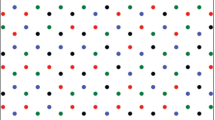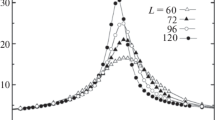Abstract
We prove that theq-state Potts antiferromagnet on a lattice of maximum coordination numberr exhibits exponential decay of correlations uniformly at all temperatures (including zero temperature) wheneverq>2r. We also prove slightly better bounds for several two-dimensional lattices: square lattice (exponential decay forq≥7), triangular lattice (q≥11), hexagonal lattice (q≥4), and Kagomé lattice (q≥6). The proofs are based on the Dobrushin uniqueness theorem.
Similar content being viewed by others
References
R. L. Dobrushin,Theor. Prob. Appl. 13:197 (1968).
R. L. Dobrushin,Theor. Prob. Appl. 15:458 (1970).
H.-O. Georgii,Gibbs Measures and Phase Transitions (de Gruyter, Berlin, 1988).
B. Simon,The Statistical Mechanics of Lattice Gases (Princeton University Press, Princeton, New Jersey, 1993).
R. B. Potts,Proc. Camb. Phil. Soc. 48:106 (1952).
F. Y. Wu,Rev. Mod. Phys. 54:235 (1982);55:315 (E) (1983).
F. Y. Wu,J. Appl. Phys. 55:2421 (1984).
J. Stephenson,J. Math. Phys. 5:1009 (1964).
I. Syozi, InPhase Transitions and Critical Phenomena, Vol. 1, C. Domb and M. S. Green, eds. (Academic Press, New York, 1972).
R. J. Baxter,Exactly Solved Models in Statistical Mechanics (Academic Press, New York, 1982).
R. J. Baxter,Proc. R. Soc. Lond. A 383:43 (1982).
L. Onsager,Phys. Rev. 65:117 (1944).
A. Lenard, Cited in E. H. Lieb,Phys. Rev. 162:162 (1967), pp. 169–170.
R. J. Baxter,J. Math. Phys. 11:3116 (1970).
T. T. Truong and K. D. Schotte,J. Phys. A 19:1477 (1986).
P. A. Pearce and K. A. Seaton,Ann. Phys. 193:326 (1989).
D. Kim and P. A. Pearce,J. Phys. A 22:1439 (1989).
C. L. Henley, In preparation; J. K. Burton and C. L. Henley, In preparation.
S. J. Ferreira and A. D. Sokal,Phys. Rev. B 51:6727 (1995); and in preparation.
H. Saleur,Commun. Math. Phys. 132:657 (1990).
H. Saleur,Nucl. Phys. B 360:219 (1991).
R. J. Baxter, H. N. V. Temperley and S. E. Ashley,Proc. R. Soc. Lond. A 358:535 (1978).
R. J. Baxter,J. Phys. A 19:2821 (1986).
R. J. Baxter,J. Phys. A 20:5241 (1987).
R. J. Baxter,J. Math. Phys. 11:784 (1970).
A. van Enter, R. Fernández, and A. D. Sokal, Unpublished.
J. Adler, A. Brandt, W. Janke, and S. Shmulyan,J. Phys. A 28:5117 (1995).
P. W. Kasteleyn and C. M. Fortuin,J. Phys. Soc. Jpn. 26 (Suppl.):11 (1969).
C. M. Fortuin and P. W. Kasteleyn,Physica 57:536 (1972).
C. M. Fortuin,Physica 58:393 (1972);59:545 (1972).
R. J. Baxter, S. B. Kelland, and F. Y. Wu,J. Phys. A 9:397 (1976).
M. Takano, T. Shinjo, and T. Takada,J. Phys. Soc. Jpn. 30:1049 (1971).
C. Broholm, G. Aeppli, G. Espinosa, and A. S. Cooper,J. Appl. Phys. 69: 4968 (1991).
D. Huse and A. D. Rutemberg,Phys. Rev. B 45:7536 (1992).
J. Kondev and C. L. Henley,Nucl. Phys. B 464:540 (1996).
A. C. D. van Enter, R. Fernández, and A. D. Sokal,J. Stat. Phys. 72:879 (1993).
C. Preston,Random Fields (Springer-Verlag, Berlin, 1976).
R. L. Dobrushin and S. B. Shlosman, Constructive criterion for the uniqueness of the Gibbs field, inStatistical Physics and Dynamical Systems, J. Fritz, A. Jaffe, and D. Szász, eds. (Birkhäuser, Boston, 1985).
R. L. Dobrushin and S. B. Shlosman, Completely analytical Gibbs fields, inStatistical Physics and Dynamical Systems, J. Fritz, A. Jaffe, and D. Szász, eds. (Birkhäuser, Boston, 1985).
R. L. Dobrushin and S. B. Shlosman,J. Stat. Phys. 46:983 (1987).
D. C. Radulescu and D. F. Styer,J. Stat. Phys. 49:281 (1987).
K. Haller and T. Kennedy, Absence of renormalization group pathologies near the critical temperature—Two examples, University of Arizona preprint [mp-arc/95-505].
M. R. Jerrum,Random Structures and Algorithms 7:157 (1995).
Author information
Authors and Affiliations
Rights and permissions
About this article
Cite this article
Salas, J., Sokal, A.D. Absence of phase transition for antiferromagnetic Potts models via the Dobrushin uniqueness theorem. J Stat Phys 86, 551–579 (1997). https://doi.org/10.1007/BF02199113
Received:
Accepted:
Issue Date:
DOI: https://doi.org/10.1007/BF02199113




